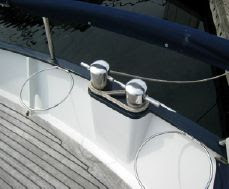- Joined
- Apr 15, 2008
- Messages
- 13,731
- Location
- California Delta
- Vessel Name
- FlyWright
- Vessel Make
- 1977 Marshall Californian 34 LRC
Since I purchased my 34 Californian, I've wondered if the cleats were properly secured with backing plates since the area under the stern and spring cleats is so difficult to access. Well, I found out this summer that they are not even through bolted when I popped 2 cleats during separate raft ups with fellow TFers.
First time in May with Dswizzler in his 58 Vantare. The height disparity in our boats resulted in a vertical load on the aft cleat when our rocking boats got out of sync. Out came the cleat, but it remained attached to the line.
The second one came last week when rafted with Giggitoni in his 42 GB. In the past our boats always seemed to move in unison with very little problem. At one anchorage, our boats rocked out of sync and my spring cleat popped off into Davey Jones' locker.
Now I'm shopping for replacement spring cleats and looking for advice on how to access the areas to allow proper back-plating and bolting. Have any fellow 34 Californian members faced this issue? Any solutions?
My current (and only remaining) spring cleat is only a 6 inch cleat and will be replaced with matching larger cleat. I'm thinking of an 8 inch cleat like this one from H-C. It should be able to handle up to a 5/8 line.
8" Stainless Open Base Cleat
I'm trying to avoid an even larger cleat since all dock access to the boat is over the side rails which are lowest just aft of the cleats. I recommend the 'sit-and-spin' method for passengers who are less agile or short-legged. A taller cleat could interfere with this method if they swing their legs fwd as many seem to do. Thoughts and advice?
First time in May with Dswizzler in his 58 Vantare. The height disparity in our boats resulted in a vertical load on the aft cleat when our rocking boats got out of sync. Out came the cleat, but it remained attached to the line.
The second one came last week when rafted with Giggitoni in his 42 GB. In the past our boats always seemed to move in unison with very little problem. At one anchorage, our boats rocked out of sync and my spring cleat popped off into Davey Jones' locker.
Now I'm shopping for replacement spring cleats and looking for advice on how to access the areas to allow proper back-plating and bolting. Have any fellow 34 Californian members faced this issue? Any solutions?
My current (and only remaining) spring cleat is only a 6 inch cleat and will be replaced with matching larger cleat. I'm thinking of an 8 inch cleat like this one from H-C. It should be able to handle up to a 5/8 line.
8" Stainless Open Base Cleat
I'm trying to avoid an even larger cleat since all dock access to the boat is over the side rails which are lowest just aft of the cleats. I recommend the 'sit-and-spin' method for passengers who are less agile or short-legged. A taller cleat could interfere with this method if they swing their legs fwd as many seem to do. Thoughts and advice?










